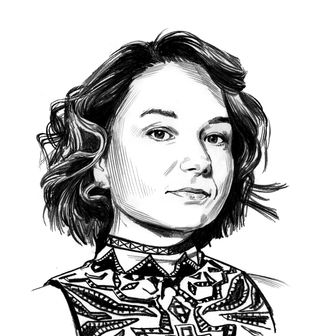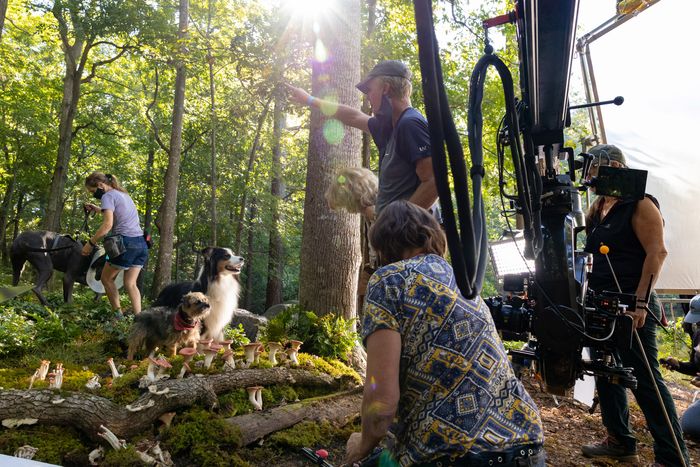
Maybe you have big feelings about your mom, so you’ve been sobbing over Barbie. Maybe you have big feelings about being part of humanity’s last chapter, so have been sobbing over Oppenheimer. But me? I’ve been sobbing since March, when about ten seconds into the trailer for Strays, Will Forte’s character throws a beer can at a plucky little terrier named Reggie. I became fixated on this image: someone being mean to a little dog that is so full of love. Like a parent checking under a child’s bed for ghosts, I had to know that no dogs experienced sadness during the making of this film before I could move on with my life as an adult who does have a job.
What I learned over the course of multiple interviews with the film’s animal trainers was simple: More movies should be about dogs. A dog-centric feature like Strays, which follows a neglected terrier on his journey to try to get back to the owner who hates him, almost requires a set to be full of good, happy vibes, because dogs simply won’t perform under duress. Or as Strays’s head trainer, Mark Forbes, puts it, “I can’t give the dogs a bigger paycheck; it has to be fun for them or they’re not going to do it.” His team at Birds & Animals Unlimited has worked for decades on animal-starring films like the Ace Ventura series and the 1996 live-action 101 Dalmatians, and he is adamant that the key to working with animals is for the entire crew to help create a comfortable environment. For dogs, this means being patient and not letting things get too scary or loud or cold. When you’re making a movie where many scenes only star dogs, this becomes all the more imperative.
Reggie, the main terrier in question, was played by a plucky little gender-bending girl dog named Sophie (if at any point you see Reggie with a penis or balls, those were added in post.) She was trained by and lives with Mathilde de Cagny, a Paris-born trainer now located in Los Angeles who has been working with dogs for 38 years. She assured me that Sophie has the brave, stout heart of a terrier and was unfazed by things like thrown beer cans or Will Forte’s presence. De Cagny described the process of filming the scenes where Forte is cruel to Reggie as one of acclimation and careful editing: Forte would sit next to Sophie as he ran his lines, slowly increasing the volume of his voice for the dialogue that needed to be shouted while offering Sophie treats. For moments when he had to be too loud, Sophie simply wouldn’t be there and they’d edit shots of her in later.
But the scenes with Forte were not even close to the most challenging for the trainers and their dogs. That honor went to shots that required the dogs themselves to work together. (The cast included not only the four star dogs, Elsa, Sophie, Benny, and Dahlin, but also their doubles and stand-ins, as well as other canine co-stars that appear throughout the film.) Each dog had 70 commands to learn and perform, often in close proximity to each other, which was not Sophie’s favorite thing. As she is a rare only-child dog — she was born with no siblings — she’s especially reactive to the presence of dogs she doesn’t know. “She barks really loud,” de Cagny told me. “So she scares everybody.” Once she got the chance to sniff out new arrivals, like when one of the other three main dogs had their double swapped in, de Cagny said she was quick to accept them and the group became “such a pack.”
In contrast, Sophie’s co-star Benny — the Boston terrier that played Bug, a streetwise stray who agrees to show Reggie the ropes — was described to me by his trainer and owner, April Mackin, as just, well, a little guy. “Benny is very sensitive and he can get his feelings hurt really fast,” Mackin told me over Zoom as Benny sat perfectly still right next to her in his own chair, like a true professional. Though the production filmed in Atlanta, the fall weather necessitated he wear sweaters and lie on a heating pad between takes. He was also sometimes overwhelmed by Sophie’s brashness. In a scene almost every trainer brought up as the hardest to pull off, all four of the dogs dig a hole under a fence together. One shot required Benny to rush toward Sophie; she barked loudly enough at him that Benny declined to do it again, and his double, a much less shy Boston terrier named Fly, had to step in. Fly took over again for the scene in which Bug gets scooped up by a hawk. The production fitted Benny with a custom harness they could use against a green screen, but it ended up being so comfortable that he didn’t wriggle at all, making it look like he was perfectly fine being carried to his doom. Fly was able to deliver a more active performance, to the filmmakers’ relief.
Often, a star dog acts as the “face” of its character by sitting still for close-ups, while its double is better at executing certain actions. That said, Dahlin, the Great Dane that plays Hunter, a therapy dog who is forever in a cone, was almost cut from certain scenes entirely due to his desire to run around and play instead of standing on his mark. Kristy Gerosky, who trained Dahlin and his double, Ike, explained that “Danes take a while to grow up” and “they do not know they are big dogs.” This is also why they scare easily, she says. “One day on set, somebody had their beagle puppy, and the puppy barked at Ike and he cowered away, like, ‘Oh, that’s going to get me.’” She said Dahlin shared Benny’s reservations about the digging scene, due to one of the other dogs “looking at him funny.” But he otherwise relished attention from humans. “Ike would be like, ‘Why is everyone looking at me? This isn’t good,’ whereas Dahlin is like, ‘Yeah, you’re looking at me. I’m cool. I’m cute. Of course you’re looking at me.’”
One dog no one had any concerns about at all was an Australian shepherd named Elsa, the Meryl Streep of this movie. She plays Maggie, a frustrated Aussie whose owner has all but replaced her with a more Instagram-friendly Chihuahua, and comes from a background in film and theater, having worked at the Universal Animal Actors show at Universal Studios in Florida. Since her usual trainer, Tammy Blackburn, needed to help with Sophie’s performance, Elsa agreed to follow direction from head trainer Forbes himself — to an extent. “She’s pretty sure that she’s in charge, not only of me but of the other dogs,” Forbes said. “If she ever reacted to the other dogs, it was more like, ‘Guys, come on. Let’s go. Get your stuff together,’ because she’s done her homework, she’s on the line, she’s waiting, she’s ready to go.” The Danes in particular became the subject of some of her frustrations, the Ronald Weasley to her Hermione, if you will. “She was the girl in the class that sat in the front row, had her hand up, knew every answer,” he added. “That was Elsa.”
Toward the end of our conversation, I asked Forbes about how industry shutdowns, like those happening due to the double strike or during the height of COVID, affect his canine performers. Do they miss going to set? “Absolutely,” he answered without hesitation. “They want to go every day.” So in the end, my worst fears are a reality: Many dogs are actually sad, not about being in the movie Strays, but because they cannot go to work right now to do fun tricks for treats. We already knew there was a massive human cost to this industry-wide shutdown, but now that there’s a dog cost? Bob Iger, open your wallet.



